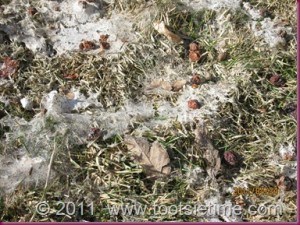Splendor in the Grass?! Nope, You’ve Got Snow Mold!
After another brutal winter in the Spruce Grove, Stony Plain, Parkland County and Edmonton area, you can finally look out your windows and see grass instead of mounds of snow. But what is that dull fuzzy coating in circles on your lawn? And how did it get there? You, my friend, have been afflicted by the dreaded “snow mold”!
What is snow mold?
Snow mold is a fungus that shows up in the early spring as snow melts. According to Lawncare.about.com, there are two types of snow mold. Pink snow mold (or Fusarium patch) grows in a pinkish web-like mycelium on the surface of the grass. When the grass is wet, the mycelium resembles white cobwebs, but as it matures it changes to a pink or salmon color. The mycelium disappears as the grass dries. Gray snow mold (Typhula blight) has a mycelium that stays a whitish-gray color. If you look closely at the grass blades infected by gray snow mold, you may see tiny black mycelial masses (sclerotia). Plants infected with pink snow mold will not have these, but pink snow mold is actually more damaging than the gray variety because it can destroy the roots and crowns of grass. And, just to keep things interesting, it’s possible for your lawn to be infected with both!
What causes snow mold?
Many of us think of mold as an organism that flourishes in warm, damp places. While other fungi live it up during the warm summer months, snow mold is dormant, only coming out to play when the weather is cold and wet. Snow mold especially loves long periods of snow cover on ground that is not completely frozen. Sounds a lot like spring in our region, doesn’t it? Snow mold also shows up in yards that were neglected in the fall: grass left unmowed and leaves not raked before the first snowfall.
How do I stop it?
Prevention:
- Change your lawn fertilizer at the end of summer to one with much less nitrogen. This will slow down lawn growth.
- Continue to mow your lawn until growth stops. This will leave a short turf that won’t fall over on itself during the winter, giving snow mold less chance of taking hold.
- Remove any dead leaves from your lawn so that nothing is covering the grass.
Repair:
If snow mold is sitting on your lawn right now, don’t panic. Most snow mold damage will repair itself as the area dries and the grass grows out in the warm spring weather. If you are bothered by the ugly look of snow mold in your yard or an allergic reaction to breathing in the spores, you may want to help things along by lightly raking the grass as it dries. Reduce any piles of snow that still remain in shaded areas. Overseed bare patches if necessary, and then allow the natural growth process to fill out your lawn. For more detailed instructions on dealing with snow mold infested grass in the spring, check out “Snow Mold: Causes and Prevention”, an article from Babes Lawn Care.com.
Looking to buy a property with a great lawn or sell your well-tended garden property this spring? Let’s talk! Call or text me at 780-910-9669, email me at barry@barryt.ca, or contact me here.
Tags: landscaping, lawn care



